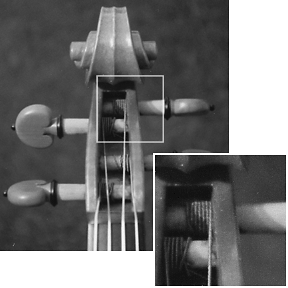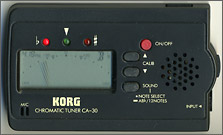|
broken string
If a string breaks on your instrument, don't panic! It
happens. If you have an extra in your case already, great, if
not, you'll have to go out and get one. If you call the violin
shop or music store before you go, you can ask if there will be
anyone who can change the string for you. If not, the string is
not so hard to put on yourself, just be careful not to
over-tighten it.
One end of the string will usually have a ball or loop, the
other end will just be wound and straight. First remove the
broken string completely. Next insert the straight end of the
string (without the loop or ball) into the tiny hole in the
tuning peg. Push the string all the way through until about 3/8
inch is poking out the other side of the tuning peg. Carefully
start to wind the peg away from you, when the end that's poking
out comes full circle, try to overlap it with the string that's
being wound, this way it won't slip out when playing. Also it's
best to wind the string in the direction of the peg you are
holding, it will hold better.

Do not wind the string all the way yet, however you'll need
to keep some tension on the string to keep it from unwinding.
Now put the ball or loop in its holder at the tailpiece. Now
start to tighten the string fully. If you are worried about over
tightening, just get the string to the point where it has a
little tension on it and bring it to your next lesson to be
tuned.
|
|
|
tuning your strings
If you're just starting out, it may or may not be difficult
to tune your instrument. I'd recommend that you get a "pitch
pipe" or electronic tuner to help you with tuning your strings.
You'll need a pipe that is made for tuning the violin with the
notes "G, D, A and E", or the viola with the notes "C, G, D and
A". Simply blow through the pipe and be sure you're tuning the
right string. Try to match the pitch of the string to the pipe,
while tuning, always ask yourself, "is the note on my violin
string higher or lower than what I'm hearing on the pitch pipe?"
Adjust accordingly. Don't get frustrated if this seems terribly
difficult, it can be and may take some time to learn to do.
Intonation, like anything else, will need to be learned over
time.
If you'd rather use an electronic tuner, these are fairly
easy and straightforward to use, pluck or bow the string and the
tuner will indicate if the string needs to be raised in pitch
(tightened) or lowered (loosened.)

Electronic Tuner
Here are 30 second recordings of the violin / viola
string tones:
A,
E,
D,
G and also the low
C for viola. (Don't worry, your television has not gone off
the air.)
|
|